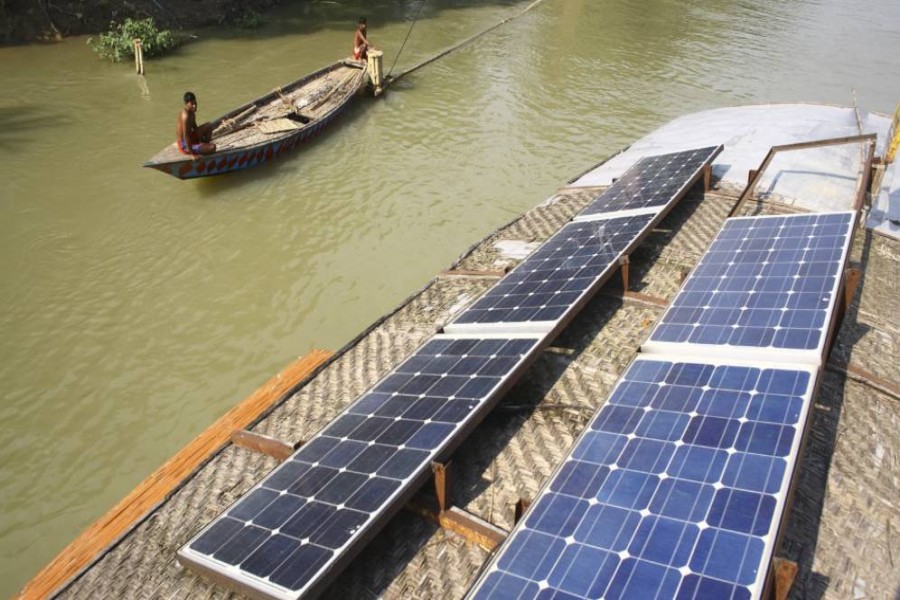
Published :
Updated :

Bangladesh is set to suffer in the long run from severe impacts of climate change, particularly increased flooding related to sea-level rise and storm surges. The current floods and heat waves are a harbinger of worse climatic conditions. As a remedial measure, the country is planning to cut off the greenhouse emission by 15 per cent from a Business as Usual (BAU) level by 2030. But the transition to renewable energy leaves a lot to be desired. Recent energy crisis worldwide could accelerate the use of renewable energy which seems to be the only sustainable solution right now.
The energy fabrication from renewable sources is comparatively small in Bangladesh. The World Bank report says, the electricity production from renewable energy was just 1.2 per cent of total power generation in 2015 which was 11.4 per cent in 1990. The portion of renewable electricity generation in the overall power production is lessening each year. Renewable energies for instance, solar, biogas, wind, and hydroelectric power are the most prevalent renewable energy sources in Bangladesh at present. The Karnaphuli Hydro Power Station is the only power plant that harvests 230 MW of electrical energy for the country.
Energy from wind is obtained largely in coastal localities and off coastline parts where wind dominance prevails. Currently two areas of the country for instance, Feni and Kutubdia have 2MW of proven wind energy generation turbines. An extra 50-200 MW from wind turbine is under development at Parky Beach. Moreover, the country has the capability to construct 30 GW of onshore and offshore wind energy. There are additional sources of renewable energy in the country, amongst which biogas has some prospects and is mostly accumulated from animal and municipal waste as part of sustainable waste management. The other highly prospective source can be sunlight. A recent SREDA report states that the country could cultivate 30 GW of solar energy by 2041.
Therefore, the renewable energy sector of the country could be a potential energy sector. According to the World Bank, Bangladesh is in the top 20 economies in terms of GDP growth which necessitates increasing energy consumption. The spread share of the energy supply is 55per cent, 27 per cent and 15 per cent from national natural gas, biomass and waste in pastoral areas and imported oil respectively. Currently (2022), the country relies essentially on natural gas, other fossil fuels and biofuels. The current deficiency and inadequacy in the availability of exploitable fossil fuel energy is aggravated by Russia-Ukraine war, prompting a search for advanced and contemporary energy sources.
To achieve the SDGs (sustainable development goals) 2030 and graduating as an advanced country by 2041, the country requires additional energy utilization but reduction in CO2 emission. Furthermore, the country is most vulnerable to climate change as well. In this context, renewable energy could be instrumental in sustaining growth as well as safeguarding the environment.
The energy manufacturing area is thought to be the key initiator of the anthropogenic greenhouse gases (GHG). A study entitled "Relationship of Renewable and Non-renewable Energy Utilization with CO2 Emission of Bangladesh" conducted at the Bangladesh Institute of Governance and Management (BIGM) postulates that there is statistically significant positive relation between GDP, non-renewable energy and CO2 emission. However, renewable energy is negatively related. Utilising multiple econometric estimation methods, it is established that a 1.0 per cent increase in non-renewable energy use will increase CO2 emission by more than 0.75% on an average.
Because of worldwide temperature rise, the country turns out to be susceptible to climate change. Elevation of sea level, upsurge wave and tide and recurrent floods, storms, and cyclones are the effects triggered by GHG emission, especially CO2 emission prompting fossil fuel use and causing global warming. Bangladesh is contributing less to GHG emission compared to the significant CO2 discharging countries. There is a need for recognising climate change problems globally.
The flight of the renewable energy policy of Bangladesh is relatively new and commenced in 2008, when the Ministry of Power, Energy and Mineral Resources issued the policy strategies. Until 2022, the country has made small but steady progress. The slow-moving progression is due to natural factors like land scarcity and modest solar and wind potential. Delays in getting project approvals, prolonged land acquisition procedures, high equipment costs, possibility of cancellation are part of the obstacles.
Equally, exploitation of renewable energy has a high inception cost and low utilisation speed. So, the government needs to be motivated to take renewable routes. Therefore, the government needs to spend more at the initial stage on novel equipment so that efficient energy manufacturing and exploitation is ensured. Adaptation to alternative methods of energy consumption by all for ensuring environmental sustainability could provide an impetus to explore newer territories. Thus additional investigations into energy parameters can set the benchmark for sustainability of energy use requiring cross-border investment.
Mowshumi Sharmin is an Assistant Professor at Bangladesh Institute of Governance and Management (BIGM).


 For all latest news, follow The Financial Express Google News channel.
For all latest news, follow The Financial Express Google News channel.